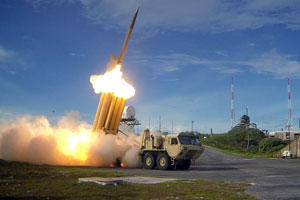

China’s ambassador to South Korea warned Tuesday that the planned deployment of a US missile defense system in the country could damage Beijing-Seoul ties, possibly irreparably. Once damaged, it would be “hard” to normalize relations between the two former Cold War enemies, Ambassador Qiu Guohong said, according to a spokesman for South Korea’s main opposition Minju party.
Qiu made the remarks when he met Minju party head Kim Jong-In at parliament. A spokesman for the Chinese embassy said the Minju party’s briefing on the meeting to journalists was accurate.
China has repeatedly protested since Washington and Seoul announced plans to install the Terminal High Altitude Area Defense system (THAAD) in the South, in response to North Korea’s recent nuclear test and rocket launch.
But Tuesday was the first time that a Chinese diplomat or official has warned of the effect on diplomatic ties with Seoul.
China fought alongside North Korea against the South and its allies during the 1950-53 war. It established diplomatic ties with Seoul only in 1992 but is now the South’s top trading partner.
Earlier on Tuesday South Korea’s defense ministry said Washington and Seoul had postponed the signing of an accord, originally due on Tuesday, on setting up a joint working group to discuss details of the THAAD deployment.
The allies announced their intention to begin talks on its deployment following Pyongyang’s long-range rocket launch on Feb. 7, which was seen by the US and its allies as a covert ballistic missile test.
China’s foreign ministry spokeswoman Hua Chunying warned Monday the deployment of THAAD should not be used as a front to “undermine China’s own legitimate (security) interests.”
The South’s defense ministry reiterated Tuesday that the US system only targets North Korean missiles and that its deployment was an issue between the two allies.
The ministry said it expects official talks on THAAD to begin next week once the two sides set up the joint working group later this week.
Terminal High Altitude Area Defense
The Terminal High Altitude Area Defense (THAAD) element provides the Ballistic Missile Defense System (BMDS) with a globally-transportable, rapidly-deployable capability to intercept and destroy ballistic missiles inside or outside the atmosphere during their final, or terminal, phase of flight.
The THAAD system fires anti-ballistic missiles to smash into enemy missiles either inside or outside the Earth’s atmosphere during their final flight phase.
The interceptor missiles carry no warheads, instead relying on kinetic energy to destroy their targets.
Overview (THAAD)
- Land-based element capable of shooting down a ballistic missile both inside and just outside the atmosphere.
- Highly effective against the asymmetric ballistic missile threats.
- Uses hit-to-kill technology whereby kinetic energy destroys the incoming
- The high-altitude intercept mitigates effects of enemy weapons of mass destruction before they reach the ground.
Details (THAAD)
- THAAD battery consists of four main components:
- Launcher: Truck-mounted, highly-mobile, able to be stored; interceptors can be fired and rapidly reloaded.
- Interceptors: Eight per launcher.
- Radar: Army Navy/Transportable Radar Surveillance (AN/TPY-2) - Largest air-transportable x-band radar in the world searches, tracks, and discriminates objects and provides updated tracking data to the interceptor.
- Fire Control: Communication and data-management backbone; links THAAD components together; links THAAD to external Command and Control nodes and to the entire BMDS; plans and executes intercept solutions.
- Rapidly deployable by being globally-transportable via air, land and sea.
Development (THAAD)
- State-of-the-art engineering ensures high standards and efficient production and maintenance.
- Comprehensive program of ground and flight tests, quality assurance, and design and development activities support mission success.
- Major events in the THAAD Program:
- Returned to flight test on November 22, 2005 at White Sands Missile Range, New Mexico;
- Completed 13 successful tests, including 11 intercepts, and operationally-realistic tests in March 2009, June 2010, October 2011, October 2012 and September 2013;
- Continuing element development to incrementally improve missile defense capability.
Procurement
- First two batteries fielded at Fort Bliss, Texas. Total hardware for Batteries #1 & #2 includes six Launchers, two Fire Control and Communications Components, two AN/TPY-2 radars, and 48 Delivered 50th operational interceptor in 2012.
- Battery #3 completed delivery in 2013 and Battery #4 completed delivery in
- Battery #5 on contract in 2012 with delivery in
- Battery #6 & #7 on contract in
Fielding
- Activated five THAAD batteries in 2008, 2009, 2012, 2014, and
- Received Conditional Materiel Release of two batteries and transition of operations to the Army in February 2012 and Urgent Materiel Release of another two batteries in December
- New Equipment Training (NET) for Battery #4 began in NET scheduled to begin for Battery #5 in 2015.
Nov 1., 2015: A Terminal High Altitude Area Defense (THAAD) interceptor is launched from a THAAD battery located on Wake Island, during Flight Test Operational (FTO)-02 Event 2a. During the test, the THAAD system successfully intercepted two air-launched ballistic missile targets.
The Missile Defense Agency awarded Lockheed Martin (NYSE:LMT) a $528 million contract in December 2015 for production and delivery of interceptors for the Terminal High Altitude Area Defense (THAAD) system. The new interceptors will support a growing number of U.S. Army THAAD units.